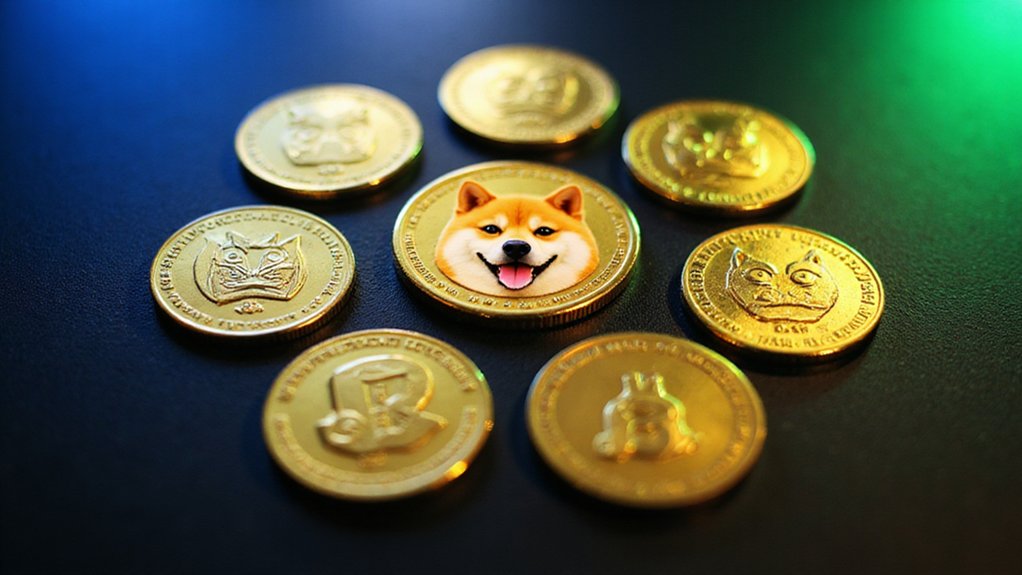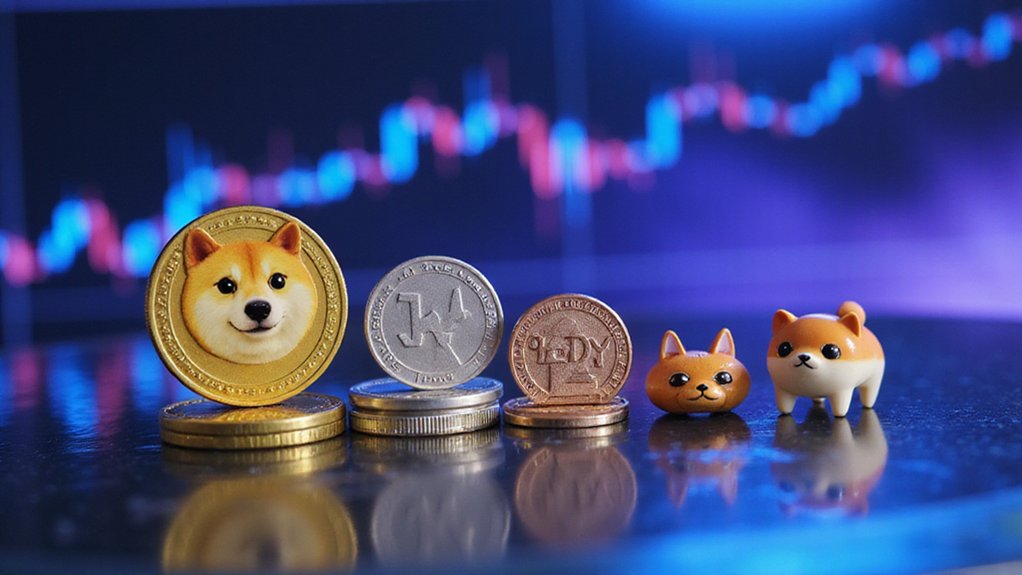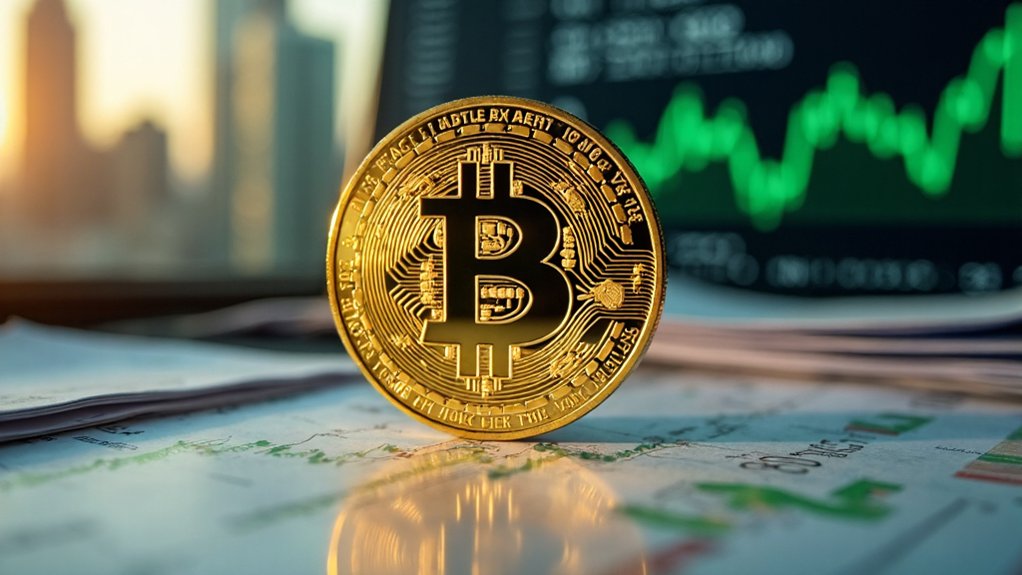The cryptocurrency landscape’s most prominent meme coins include Dogecoin (the original Shiba Inu-themed pioneer with a $50 billion peak valuation), Shiba Inu (the self-proclaimed “Dogecoin killer”), Pepe (the amphibian-inspired sensation with 400% post-launch growth), Floki Inu (named after Musk’s dog), and Bonk (Solana’s canine contender). Newer entrants like Dogwifhat and AI-integrated offerings such as Mind of Pepe demonstrate the sector’s evolution beyond mere jokes into substantial digital assets with expanding technological capabilities. The full story behind these internet culture-turned-financial instruments reveals surprising depth.

The meteoric rise of meme-based cryptocurrencies—those digital assets born not from utopian visions of financial revolution but rather from internet jokes and viral images—represents perhaps the most fascinating (and occasionally baffling) development in modern financial markets.
In cryptocurrency’s wild frontier, meme coins transmute internet humor into financial instruments with surprising staying power.
Dogecoin, the patriarch of this peculiar asset class, transformed from a 2013 Bitcoin parody featuring a Shiba Inu dog into a legitimate financial instrument with a market capitalization exceeding $50 billion by early 2025. Its unlimited supply and Proof of Work consensus mechanism notwithstanding, DOGE’s staying power has confounded traditional financial analysts for over a decade.
Following this unlikely trailblazer, Shiba Inu (SHIB) emerged in 2020 as a self-proclaimed “Dogecoin killer,” establishing itself on Ethereum’s network and adopting Proof of Stake validation. With a $10 billion valuation and ranking as the 19th largest cryptocurrency, SHIB demonstrates the remarkable durability of what skeptics once dismissed as mere internet ephemera.
The amphibian-inspired Pepe (PEPE) joined the fray in 2023, capturing the zeitgeist with extraordinary 400% post-launch growth and securing a position among the top 40 cryptocurrencies despite—or perhaps because of—its extreme volatility. Meanwhile, Floki Inu (named after Elon Musk’s canine companion) and Solana-based Bonk have diversified beyond their memetic origins into NFTs, metaverse gaming, and DeFi applications. These coins thrive primarily on social media hype and robust community engagement rather than traditional utility or technological innovation.
The sector’s evolution continues with newer entrants demonstrating increasingly sophisticated approaches.
Dogwifhat (WIF) achieved a remarkable $4.5 billion market cap within four months of its Solana debut.
Bitcoin Bull (BTCBULL) cleverly ties rewards to Bitcoin price milestones, while Solaxy (SOLX) addresses actual network congestion issues.
Perhaps most intriguing are the AI-integrated offerings—Mind of Pepe (MIND) providing market insights and ai16z developing AI agent frameworks. These AI-powered coins offer traders early trend spotting capabilities that could revolutionize investment strategies in the volatile meme coin market.
The meme coin sector’s 500% market capitalization growth in 2024 reflects both its cultural resonance and remarkable investment appeal. These tokens represent some of the most speculative assets in the crypto ecosystem, yet their communities have transformed initially dismissed jokes into legitimate financial instruments with passionate communities driving their adoption and valuation, proving that in cryptocurrency markets, cultural capital can indeed transmute into actual capital.
Frequently Asked Questions
How Do Meme Coins Differ From Traditional Cryptocurrencies?
Meme coins fundamentally diverge from traditional cryptocurrencies in their origin, utility, and market behavior.
While established cryptos like Bitcoin and Ethereum serve specific financial functions with technological innovation, meme coins emerge from internet culture solely to capitalize on social momentum.
Traditional cryptocurrencies typically feature structured tokenomics and development roadmaps, whereas meme coins—often characterized by unlimited supplies and extreme volatility—rely almost exclusively on community hype and viral marketing rather than substantive utility or technological advancement.
Are Meme Coins a Good Long-Term Investment?
Meme coins represent a particularly speculative subset of crypto assets that, despite occasional meteoric rises, fundamentally lack the substantial use cases, technological innovation, or intrinsic value that might justify long-term investment consideration.
Their dependence on social media momentum and celebrity endorsements, coupled with dismal survival rates and regulatory uncertainty, renders them closer to lottery tickets than viable investment vehicles.
The $90B+ allocated to these assets might be charitably described as misallocated capital seeking adrenaline rather than appreciation.
What Risks Should I Know Before Investing in Meme Coins?
Meme coin investments harbor multifaceted risks that merit sober consideration.
Beyond their notorious volatility—where 200% gains can evaporate overnight—these speculative assets typically lack fundamental utility or intrinsic value.
The ecosystem remains plagued by pump-and-dump schemes and wash trading, while regulatory ambiguity looms ominously overhead.
Limited liquidity can transform exit strategies into Kafkaesque nightmares, leaving investors holding devalued tokens in a market where emotional decision-making often trumps rational analysis.
How Do I Spot the Next Potential Viral Meme Coin?
Identifying nascent viral meme coins requires vigilant analysis of multivariate signals—community vibrancy (measured through engagement metrics), social momentum (particularly exponential growth on Twitter/Discord), and influencer radar proximity.
The astute observer watches for tokenomics with reasonable distribution mechanisms and absence of concentrated ownership.
Market behavior patterns—particularly unusual volume spikes preceding mainstream attention—often telegraph potential breakouts.
The truly prescient investor recognizes cultural zeitgeist alignment before the masses do (a remarkably difficult, debatably impossible task).
Can Meme Coins Actually Develop Practical Utility Over Time?
While initially conceived as speculative vehicles, meme coins can indeed develop substantive utility.
Projects like Shiba Inu and Dogecoin have evolved beyond their joke origins by implementing DeFi features, governance mechanisms, and real-world payment systems.
The integration of staking, NFT compatibility, and cross-chain functionality transforms these tokens from mere internet curiosities into functional digital assets.
However, this maturation remains the exception rather than the rule in a market still dominated by ephemeral projects.









